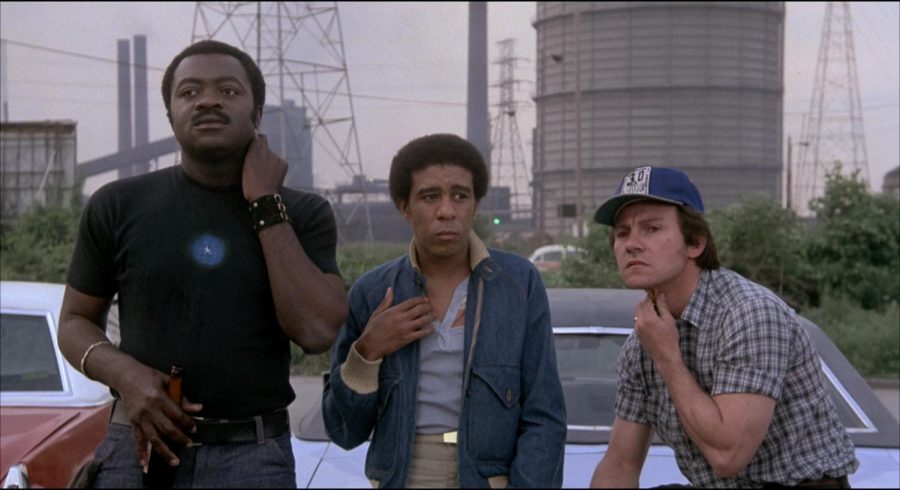Review: “Blue Collar”
Paul Schrader’s 1978 directorial debut is a morality play from hell. “Blue Collar” is currently playing at Film Forum until July 22.
Paul Schrader’s directorial debut, “Blue Collar,” is a 1978 American crime drama film following three blue-collar workers. This film is currently playing at Film Forum until July 22. (Image Courtesy of Universal Pictures)
July 20, 2021
As a hard cocktail of proletariat pornography and moral conundrums, Paul Schrader’s 1978 film “Blue Collar” contains enough muscular men hard at work to make Rivera jealous and enough dread to make Nietzsche grin.
As the title suggests, the film follows three blue-collar workers — Zeke Brown (Richard Pryor), Jerry Bartowski (Harvey Keitel) and Smokey James (Yaphet Kotto) — who do not do much beyond building cars, drinking beers and accumulating debts. So when the IRS comes knocking at one of their doors demanding $2,000, it’s as if an anfractuous dynamite stick begins to burn; the film takes on the form of a flame so unpredictable you can’t help but gawk as it makes its way toward an inevitably cataclysmic boom.
From the get-go, “Blue Collar” thrusts you into the daily toil of its leading trio by putting together a glorious montage chock-full of sweat, denim and auto parts. Set to the heavy strumming of “I’m a Man” and anchored by a devilish drum-beat courtesy of Jack Nitzsche (not to be confused with Friedrich), Schrader announces himself as a director whose command over the seventh art few filmmakers could claim over the course of their careers.
Hot off the success of 1976’s “Taxi Driver,” Schrader showcases in “Blue Collar” the unbridled cinematic genius we’ve come to know and love him for. His knack for making audiences squirm is supported by his ability to extract sympathy from them, and “Blue Collar” does an amazing job of balancing moments that tug on your soul with those that punch at your gut.
Schrader and his brother Leonard, with whom he co-wrote “Blue Collar,” write characters worth cherishing, but their writing only goes so far. It is the lived-in performances offered by Pryor, Keitel and Kotto that make “Blue Collar” so enrapturing. The three of them, each in their own way, embody their roles to perfection, tugging on your eyes every time they’re on screen in a way that keeps you consistently engaged through the magnetism of exploited idiosyncrasies.
Although Keitel and Kotto carry the typical workwear-clad stoicism associated with America’s vision of the blue-collar worker, Pryor represents a different face of the American worker altogether. He is a fiery, loud-mouthed, impassioned and all-too-disgruntled factory worker who clamors for change despite being aware that he’ll probably not see much of it during his lifetime. As such, his concerns are much more immediate: getting paid and getting laid; that is, until the government comes knocking at his door and he suddenly has to think about how to pay up before he gets sent off.
With a whiff of cocaine Zeke realizes how easy it’d be to steal some cash from the union that misrepresents him and his comrades. Perhaps the drugs are doing a lot of the talking (and thinking), but after a few fits of desperation from the rest of the crew, it seems everybody’s on board.
From here on out, “Blue Collar” exclusively operates at a spine-tingling level, running off feverish fumes as each moment builds on top of the last to create the sketchiest Jenga tower of moral mechanics. A botched heist becomes an amateurish blackmail that swirls out of control into a conspiracy involving everyone from the head of the union to the FBI. By the time members of the cast start dying in suspicious accidents, its characters’ paranoia becomes all too palpable and oozes off the screen. The trio’s initial desire to get enough money to get by twists itself into a situation where they find themselves pondering how to stay alive.
It’s clear Schrader is a malicious Jenga player, but why? Why put audiences through such a stressful viewing? Why write such hearty characters only to tauntingly destroy them? As it pertains to this film, one ought to consider the title and its plight: the presence of a working class whose lives are reduced to clocking in and clocking out, hell-bent on making money, only to see it slip away as if life itself were being taxed.
Perhaps Schrader’s a cynic or a sadist given how horribly wrong everything goes for everyone in “Blue Collar.” After all, he channels the gratuitousness of Upton Sinclair but denies viewers and the working class he depicts any hope. This sentiment becomes all too apparent by his decision to cut to red right before the credits begin to stream down the screen. It’s a final dash of irony that seeps poignancy by pronouncing progress to be dead, memorializing the plight of the working class in a specific shade of red that alludes as much to leftist politics as it does to blood. Schrader’s eyes seem to have seen a lot, and with “Blue Collar,” he spells it all out, exposing the ins-and-outs of a perennial American struggle with a loupe so potent every moment on screen becomes too much to handle because of its unnerving authenticity.
Email Nicolas Pedrero-Setzer at [email protected]



























































































































































